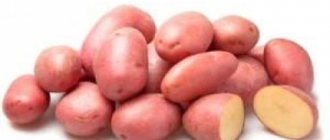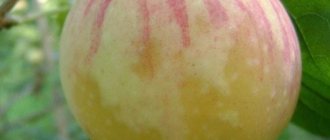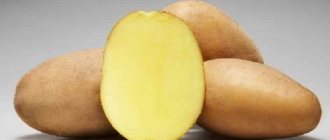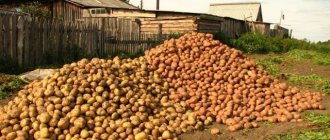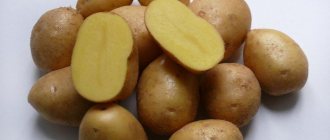If you have a summer house with a plot of land, then you most likely grow vegetables. Each gardener has several acres for growing potatoes, which is impossible to do without. Speaking about potatoes, I remember the Soviet film “Girls,” where the cook listed all kinds of dishes that can be prepared from this root vegetable. Of course, every vegetable grower is interested in the yield and taste of the vegetable he grows, so before purchasing a new variety, you need to familiarize yourself with its characteristics. Today we offer you to consider Lady Claire potatoes. A description of the variety, photos, and reviews from gardeners can be found in this article. Also, all the necessary information will be provided here in order to properly grow this variety and have a good harvest.
Potatoes Lady Claire: characteristics
Lady Claire (or Lady Claire) is an early maturing table potato variety. It was developed in Holland and quickly became popular in central Russia. It is possible to grow it in other areas, but provided that there is a temperate climate with not too hot and not too rainy summers. Vegetable growers in the southern regions can harvest two crops of the described potatoes per season if the first one is planted in early spring.
Within seventy days from the appearance of the first shoots, the tubers begin to fully ripen. A month and a half after planting the potatoes, it will be possible to dig up them and take a sample.
Lady Claire potatoes (variety description, photos, reviews are available in this article) are suitable for growing in small areas and for industrial cultivation. The variety is loved for its early ripening and high yield. Unfortunately, according to some gardeners, the taste of this potato is not as good as that of late-harvested varieties.
Description of the root vegetable
First, let's figure out what this variety is. This is an early ripening table variety. Suitable for personal plots and farms.
Large, beautiful potatoes are ideal for sale; they are stored for a long time without losing their consumer properties.
The root crop has the following features:
| Variety name | Red Lady |
| general characteristics | German table variety, tolerates drought well |
| Maturation period | 80-90 days |
| Starch content | 12-17% |
| Weight of marketable tubers | 110-140 gr |
| Number of tubers in a bush | 6-10 pieces |
| Productivity | 170-300 c/ha |
| Consumer qualities | great taste, suitable for any dish |
| Keeping quality | 92% |
| Peel color | pink |
| Flesh color | light yellow |
| Preferred Growing Regions | Central Black Earth, North Caucasian, Middle Volga, Far Eastern |
| Disease resistance | resistant to potato blight, golden cyst nematode, rot, scab, blackleg |
| Features of cultivation | Germination is recommended, the variety requires nutritious soil and long daylight hours |
| Originator | Solana (Germany) |
Productivity
Lady Claire potatoes (variety descriptions, photos and reviews are always of interest to gardeners) with the right soil produce unusually high yields. The variety prefers to grow in black soil mixed with sand. This is exactly what the ideal soil should be: fertile and light, in this soil it will be possible to collect from fourteen to eighteen tons of Lady Claire potatoes from one hectare. The yield will be much lower if you plant it in clayey, heavy soil. The highest yield of the described variety was 267 centners per hectare, which is several times higher than the current standard, which is stated in the register of the Central region.
Tubers are stored ideally all winter, and not only their presentation is preserved, but also useful substances and vitamins are not lost. As stated in the description of the variety, shelf life until the next season is more than ninety percent.
What is important for the harvest is that the tubers are not damaged during harvesting and do not burst under strong impacts. The percentage of emissions after digging up potatoes is minimal. The variety is easily transported even over long distances and does not deteriorate when left in a room for a long time, the air temperature in which does not exceed five degrees.
Harvesting and storage
The readiness of the variety for harvesting is indicated by yellowing and drying of the shoots. You cannot immediately store the tubers. First, the potatoes must be dried and sorted. Before storing, treat the tubers with copper sulfate.
The Lady Claire potato variety can be stored for more than 6 months. The optimal temperature for a vegetable storehouse or basement is + 2-4 ° C, air humidity 60-80%. It is recommended to store the Lady Claire variety in wooden boxes with sides 15-20 cm high, no more than 2 layers.
Description of the plant
The bush of the described potato grows up to fifty centimeters, it is erect and not very spreading. The stems are very juicy, do not lie on the ground, and will stand straight until harvest. The foliage of the bush is medium in size, dark green, the edges are not as wavy as those of other varieties, the veins are clearly visible.
When flowering, the bushes are covered with small white flowers. They fall off very quickly and are not able to form berries.
The potato root system is strong and well developed. Up to ten large tubers are formed under each bush. As for ugly, crooked and small potatoes, their quantity is minimal. The average weight of an edible tuber is about one hundred grams. Potatoes have an oval or round shape, there are no holes, bumps or other irregularities on the surface. There are a small number of eyes, they are small and sparse.
The peel has a yellow-cream or sandy-beige color and is rough to the touch. Despite the apparent thinness of the skin, it is still quite dense.
The pulp has a light yellow tint, it is very dense, and the dry matter content is quite high. Lady Claire potatoes have many beneficial substances for the body, such as vitamin C and carotene. The starch content is from eleven to sixteen percent.
Characteristics of varieties
Red Lady Potatoes
This variety was included in the State Register of Breeding Achievements in 2008. It is approved for cultivation in the Russian Federation on the territory of the Central Black Earth, North Caucasus, Middle Volga and Far Eastern regions. The originator of the variety is the world-famous company SAKA PFLANZENZUCHT-GBR.
The bush part of the plant is medium in height, consists of an intermediate type of erect or semi-erect stems with medium-sized leaves, closed or intermediate, green or dark green, with slightly wavy edges. The buds fall off at the stage of incomplete development.
The tubers are elongated, oval in shape and covered with a red, slightly mesh and slightly flaky skin, on which there are superficial, medium-sized eyes. The average weight of each root crop does not exceed 140-142 g. Potato pulp when cut is light yellow or beige and contains no more than 16.8-17% starch. Potatoes have a good presentation.
Potato variety "Lady Claire"
Potatoes "Lady Claire" from the originator S. Meijer are included in the State Register of Russia in the Central Federal District and are early-ripening varieties suitable for processing into dry potato products, including potato starch, potato flour, as well as for the production of chips, flakes, straws, French fries and crispy potatoes.
The bush part of the plants has an average height and belongs to the leaf type. The stems are semi-erect, covered with leaves of predominantly medium size, intermediate type, green in color. The waviness of the leaf edges is weak to medium. The flower corollas are medium-sized, white. The tubers are oval-shaped, covered with a smooth or slightly rough skin of beige-yellow color, and have small, medium-deep eyes. The average weight of a commercial root crop can vary from 83.5 to 106.8 g. The potato pulp is light, beige-yellow, with an average starch content of no more than 16.3-17%.
Red Chief apple tree: description, photos, reviews Potato BreezeHow to treat potatoes before planting against late blight
Potato variety "Lady Rosetta"
The late-ripening, universal-purpose variety “Lady Rosetta”, or Lady Rosetta, from the originator C. Meijer BV is included in the State Register for the Central Region. The variety was bred by leading Dutch specialists in the field of vegetable breeding and is very promising.
The bushes are low, compact and semi-spreading, consisting of thin, significantly colored stems with anthocyanin. The leaves are medium sized, medium open, dull green in color with medium wavy edges. Flowering is insignificant. The inflorescences are medium-sized, and the flower corollas are small, reddish in color with a pronounced purple tint. Berry formation is very rare or not observed at all.
The smooth tubers have a round shape, are covered with a red smooth skin and have small, medium-depth eyes, which have a characteristic red base. The average weight of one commercial root crop reaches 123.5 g. The potato pulp is light, creamy-yellow in color, with a starch content of no more than 21.9-22.3%.
Taste qualities
Early potato varieties are bad because they do not have such a rich and bright taste. Lady Claire is no exception to the rule, but still differs in quality from other early varieties. The vegetable is moderately boiled, the pulp is not watery.
The amount of starch allows you to make not only mashed potatoes, but also boil them, make chips, fries (in the deep fryer, the potatoes are covered with an appetizing golden crust). In addition, the variety is ideal for making starch and potato flour.
How to properly care for the variety
In general, the rules for caring for Lady Claire plantings do not differ from those required for other potato varieties
But, according to reviews from gardeners, it is necessary to pay attention to planting at least once a week
Features of watering
Thanks to the early ripening period, the growth of the bushes is very rapid. They require frequent watering, but not too much. Before flowering, it is enough to carry it out once every 3-5 days, pouring only 3 liters of water under each plant. During flowering, the norm is increased to 6 liters.
The optimal time for watering is morning or evening. In this case, it is worth using drip systems or sprinklers so as not to wash out the soil from under the bushes.
Stop watering 2 weeks before mass harvesting.
Feeding and fertilizing
It is optimal to add a sufficient amount of organic matter to the soil in the fall so that during the growing season you can only apply mineral fertilizers. To do this, during the autumn digging, add 1-2 buckets of rotted manure per 1 m² of beds. To normalize acidity, add a glass of wood ash.
In the spring, after the emergence of seedlings, 30 g of superphosphate and 15 g of potassium sulfate per 1 m² are added at intervals of 1 week.
Hilling and weeding
The absence of weeds in the area must be monitored very carefully. Their harm lies in the fact that weeds suck moisture and substances useful for potatoes from the soil, spoil the tubers with their hard roots, and spread pests and diseases. Weeding should be done as needed.
Hilled potato beds
Hilling goals:
- giving additional stability to shoots;
- protection against damage under strong winds;
- soil moisture retention;
- forming a sufficient ball of earth around the nest to obtain the maximum number of tubers.
Advantages of the variety and its disadvantages
Lady Claire has a lot of positive characteristics that appeal to both gardeners who grow potatoes only for their families and owners of large farmlands. Why was this variety able to captivate so many people?
- Of course, the first priority is productivity, which exceeds all usual standards.
- The variety is very resistant to various diseases and pest attacks.
- Lady Claire's tubers do not degenerate for a long time. Having bought the seeds once, you will be planting your own grown potatoes for many years.
- The Lady Claire variety is not too demanding to care for.
- Potatoes are widely used; all your favorite dishes can be prepared from them.
- The taste of the tubers, although not too bright, is still very pleasant. The tasting rating of the variety is 4 points out of five.
- Lady Claire's appearance is beautiful.
- The variety tolerates dry seasons well.
- Ideal for long-term storage.
- High content of amino acids, carotene, vitamins (especially C).
- Possibility of transportation over long distances.
As for bad characteristics, there are practically none. The only thing that can be noted is the quality of the soil for planting the variety, and its requirements for proper watering. With a lack of moisture, potatoes begin to shrink. But if the dry season comes at a time when the plant is quite mature, then troubles can be avoided and the harvest will not suffer.
Highly resistant varieties
Potatoes damage the most:
- Colorado beetle
- late blight
- golden nematode
Enemy #1
Fungal diseases and plant pests can destroy ½ of the crop. Therefore, it is necessary to grow plant varieties that are more resistant to diseases and insects.
In regions with a lot of rain, plants are most often susceptible to fungal diseases. It is recommended to plant the following varieties.
Sap
Sap
Domestic selection. With an average ripening period. The flowers are purple. The potatoes are yellow, creamy when cut. Weight – up to 150 g.
May contain up to 19% starch. The average yield is 16 t/ha.
Borodyansky pink
Borodyansky pink
Early. The tuber is pink. The pulp is creamy. Weight – up to 130 g. Starch content – up to 17%. High-yielding – up to 45 t/ha.
Chervona rue
Chervona rue
Originally from Ukraine. Pink potatoes with white flesh. Starch content – up to 19%.
To this list you can add the varieties described above - Bellarosa and Arosa.
All of them are resistant to late blight.
Tubers with thick skins are less susceptible to damage by plant pests.
Sante
Sante
The average weight of one potato is 120 g. Yellow. One bush gives up to 20 pieces. Contains a small amount of starch - from 10%. With an average ripening period. Productivity – 27 – 50 t/ha.
Vineta
Vineta
German selection. Early. Potatoes are brown. Inside is light brown. Weight – up to 140 g. Starch content – up to 15%. High-yielding – up to 20 t/ha.
Chervona rue and Bellarosa are also pest resistant.
Karatop
Karatop
Early. With yellow skin and light flesh. Contains up to 15% starch. The maximum weight of one potato is up to 130 g. Productivity is up to 52 t/ha.
Fantasy
Fantasy
Red potatoes with white flesh. One plant produces up to 11 pieces. Can be grown in any region of Russia. Late ripening. High-yielding – up to 52 t/ha.
Grouse
Grouse
Brought out in Ukraine. Pink potatoes with white flesh. Contains about 18% starch. Productivity – 52 t/ha.
Their ranks include such varieties as:
- Agave
- Bellarosa
- Vineta
- Arosa
The most resistant to golden nematode:
- Vineta
- Sante
- Bellarosa
- Laura
- Agave
- Arosa
25 Best varieties of tomatoes: characteristics and descriptions with reviews from gardeners | (Photo & Video)
How to prepare the seeds?
We have already written that it is possible to use homegrown potatoes for planting for several seasons, since they do not degenerate for a long time. I would like to note that experienced gardeners recommend renewing the seeds after four years and not planting tubers that you already have in the fifth season, even if they look strong. Lady Claire seed potatoes are the most important component of the harvest, and if you do not follow the rules, you may end up not growing as many tubers, and their quality will not be for the better.
In order to prepare the seeds for planting, they must be germinated two weeks before the due date. The seeds should be placed in boxes and left in a dark but warmer place than where they were stored all winter. Many gardeners are accustomed to cutting planting material in half; for Lady Claire this is contraindicated, since the potatoes may deteriorate and not germinate in the ground.
When buying seed potatoes, pay attention to the fact that even in the absence of sprouts there are live eyes. The peel should not be damaged or excessively wrinkled. The tubers should be beautiful, smooth, and have no signs of spoilage.
Planting and caring for Lady Claire potatoes
The variety is cultivated both in open ground and in heated equipped rooms. The choice of planting site depends on the growing region and the capabilities of the gardener. In places with a northern climate, cultivation of this potato variety is possible only in greenhouses.
Selection and preparation of a landing site
Lady Claire potatoes grow well in loose, well-lit and fertile soil. Able to bear fruit on loamy soil, but may die on heavy clay soil.
In the fall, the area is cleared of weeds and roots and dug up. After this, it is recommended to sow green manure, and after the emergence of seedlings, loosen the soil again.
Preparation of planting material
Obtaining a good harvest of this variety is possible with proper preparation of tubers for planting. To do this, they are sorted out and damaged, rotten samples are removed.
It is recommended to purchase Lady Claire seed potatoes from a trusted manufacturer or in specialized stores. Updating of the material is necessary every 5 years.
14 days before planting in the soil, the tubers are germinated. To do this, they are placed in a wooden box and transferred to a bright place. Gradually, sprouts appear on the root crops.
An alternative method of preparation is to place the seeds in humus or wet sawdust. The container with tubers is transferred to a room with a temperature no higher than + 15 °C.
Important! To prevent diseases, it is recommended to spray Lady Claire potatoes with a manganese solution.
Landing rules
The optimal planting time is the end of May. The air temperature should be at least + 12 °C, the soil should be well heated. In unfavorable weather conditions, it is recommended to postpone planting.
As a preventative measure against diseases and parasites, onion peels or ash are added to the soil, after which holes are formed in the classical way. The variety can be planted in trenches or ridges.
The row spacing should be about 30 cm, the seeds are placed at a depth of 8 cm.
Watering and fertilizing
Lady Claire potatoes are early-ripening varieties that are characterized by rapid growth, so frequent, but not abundant watering is important. Apply 3 liters of water to one bush (6 liters during the flowering period) every 3-5 days.
The procedure is carried out in the morning or evening. It is recommended to use a hose so as not to erode the plant's root system. 2-3 weeks before harvesting, reduce the amount of watering.
Light fertile soil needs to be moistened more often than heavy soil. It is not recommended to use ice water for irrigation, so it is left in a container in the sun.
It is recommended to apply all fertilizing and fertilizers in the fall during soil preparation. In addition to green manure, organic and mineral fertilizers are used.
To do this, add 6 buckets of manure, 30 g of superphosphate and 15 g of potassium sulfate per 1 m2. To normalize the soil environment, add lime or ash (200 g per 1 m2).
Loosening and weeding
Weed removal from the site is carried out as harmful plants appear; it is possible to use both modern devices and manual weeding.
When loosening the soil, it is important not to damage the root system and tubers, so during the procedure only the top layer of soil is affected
Hilling
This stage of agricultural technology allows you to prevent the rapid growth of weeds and provide the root system with access to air and moisture. Loosened soil does not allow excess moisture to harm the tubers and destroy the crop.
Timely hilling allows you to form additional support around the potatoes, protecting them from unfavorable conditions. A sprinkled bush grows and branches more intensively, forming the maximum possible number of tubers.
Important! The first hilling procedure is carried out when the stem length is at least 5 cm, in the morning or evening.
Sequence of work when growing potatoes
Before planting, the soil must be well loosened, all weed roots and crop residues from the previous season must be removed from it. When it’s time to plant potatoes, you need to treat the soil with a manganese solution; you can also “bathe” the tubers themselves in special preparations that will prevent pest attacks. To increase productivity, humus or peat is added to the soil.
As the bushes grow, raking is necessary, that is, the formation of high beds so that there is room for the growth of Lady Claire potatoes. Watering should be done only when drought occurs; if precipitation is stable, then this should not be done. To better retain moisture, it is necessary to mulch the soil.
At the bush formation stage, it would be a good idea to fertilize the plants. To do this, apply fertilizers with potassium and phosphorus to the soil once. Do not use nitrogen-containing products, as the greens will grow at the expense of tuber formation.
A week before digging up the crop, it is necessary to trim the tops, so the tubers will accumulate more moisture and nutrients for which Lady Claire potatoes are famous. Description of the variety, photos, reviews were presented to your attention in this article.
After harvesting, the harvest must be spread out under a canopy so that it dries well.
Features of planting and care
The timing of planting Red Lady potatoes depends on the region and climatic conditions. The soil should have time to warm up and not dry out, and contain a large amount of sand. It is recommended to choose an open place to provide the plants with sufficient sunlight. In the shade, the potato bush stretches upward, and the yield is low. It is advisable that before the Red Lady, representatives of the nightshade family - eggplants, tomatoes - do not grow on the site.
Potatoes tolerate slight drought well and are undemanding when it comes to watering. Long frosts can significantly reduce yields.
For planting, you need to use medium and large tubers; small ones will not yield a harvest. Large ones can be cut into several pieces with sprouts. The sprouts, thin as threads, are immediately sorted.
This variety does not need to be germinated, but this procedure will speed up development and increase yield. Before planting, the soil is dug up to a depth of 25–30 cm. The soil is fertilized in advance (in autumn) with manure and superphosphates. In the spring, you can add ash or complex biological products to each hole. Planting pattern: 60 cm between rows, 35–40 cm between future potato bushes. Sprouted tubers should be planted to a depth of 5 cm, and unsprouted tubers – 8–10 cm.
Caring for Red Lady involves hilling, regular feeding, and eliminating weeds. It is advisable to water at least 3 times per season, especially during flowering, when tubers are set. You need to feed it at least 2 times during the entire growth period. You can mow the tops 2 weeks before harvesting. This way the tubers will form a dense skin and become more stable in storage. Freshly dug potatoes need to be air dried, sorted, and calibrated. Should be stored at air humidity of about 80% and temperature 5 0C.
Agrotechnical techniques
There is nothing difficult about growing Dutch potatoes. The Lady Claire potato variety can be planted both in open ground and in a greenhouse (relevant for northern regions). Any soil will do, as long as it is loose and nutritious and does not retain moisture.
Advice! It is best to plant Dutch potatoes in early May, when the soil is well warmed up at a depth of 10-15 cm. The best place for growing is an open area where perennial grasses previously grew.
The technology for planting potatoes is proposed as follows:
- A couple of weeks before planting, potato tubers should be brought to a warm place for germination. You can germinate Lady Claire potatoes in the sand or in the open air.
- Immediately before planting, it is recommended to treat potatoes with special chemical compounds or a solution of potassium permanganate. This will protect the tubers from pests.
- The soil on the site must be loosened in advance, weeds and their roots must be selected, and fertilizers must be spread (peat, wood ash, humus).
- The recommended planting pattern for the Lady Claire variety is as follows: 35x60 cm. The depth of the holes should not be more than ten centimeters, since in this case the tubers may rot even before germination.
Advice! You should not use nitrogen-containing mineral complexes as fertilizer for potatoes. Excess nitrogen will lead to the growth of green mass to the detriment of the number and size of tubers.
